2007 GMC SIERRA CLASSIC torque
[x] Cancel search: torquePage 141 of 674
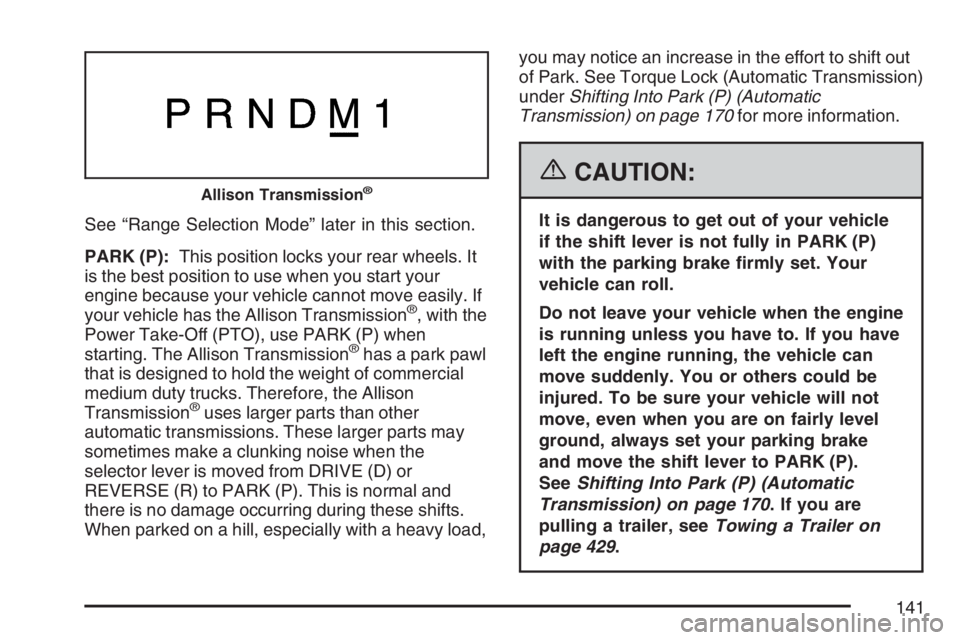
See “Range Selection Mode” later in this section.
PARK (P):This position locks your rear wheels. It
is the best position to use when you start your
engine because your vehicle cannot move easily. If
your vehicle has the Allison Transmission
®, with the
Power Take-Off (PTO), use PARK (P) when
starting. The Allison Transmission
®has a park pawl
that is designed to hold the weight of commercial
medium duty trucks. Therefore, the Allison
Transmission
®uses larger parts than other
automatic transmissions. These larger parts may
sometimes make a clunking noise when the
selector lever is moved from DRIVE (D) or
REVERSE (R) to PARK (P). This is normal and
there is no damage occurring during these shifts.
When parked on a hill, especially with a heavy load,you may notice an increase in the effort to shift out
of Park. See Torque Lock (Automatic Transmission)
underShifting Into Park (P) (Automatic
Transmission) on page 170for more information.
{CAUTION:
It is dangerous to get out of your vehicle
if the shift lever is not fully in PARK (P)
with the parking brake �rmly set. Your
vehicle can roll.
Do not leave your vehicle when the engine
is running unless you have to. If you have
left the engine running, the vehicle can
move suddenly. You or others could be
injured. To be sure your vehicle will not
move, even when you are on fairly level
ground, always set your parking brake
and move the shift lever to PARK (P).
SeeShifting Into Park (P) (Automatic
Transmission) on page 170. If you are
pulling a trailer, seeTowing a Trailer on
page 429.
Allison Transmission®
141
Page 146 of 674

Low Traction Mode
(Allison Transmission®)
If your vehicle has the DURAMAX®diesel engine
and the Allison Transmission®,ithasaLow
Traction Mode that assists in vehicle acceleration
when road conditions are slippery, such as
with ice or snow. While at a stop, selecting the
second gear range using the Range Selection
system, will allow the Allison Transmission
®to limit
torque to the wheels after it detects wheel slip,
preventing the tires from spinning.
Notice:Spinning the tires or holding the
vehicle in one place on a hill using only the
accelerator pedal may damage the
transmission. The repair will not be covered by
your warranty. If you are stuck, do not spin
the tires. When stopping on a hill, use the
brakes to hold the vehicle in place.
Cold Weather Operation
(Allison Transmission®)
On cold days, approximately 32°F (0°C) or colder,
your automatic transmission is designed to shift
differently. The transmission uses a warm-up mode
shift schedule until the engine reaches normal
operating temperature. While the transmission is
in warm-up mode it is normal for transmission
upshifts to be delayed or held longer. This feature
improves heater performance by giving quicker
vehicle warm-ups.
When temperatures are below−13°F (−25°C), the
transmission will prevent certain operations to
protect against damage. When active the DIC will
display the message “Trans in Warm-up”.
SeeDIC Warnings and Messages on page 270for
more information.
146
Page 148 of 674
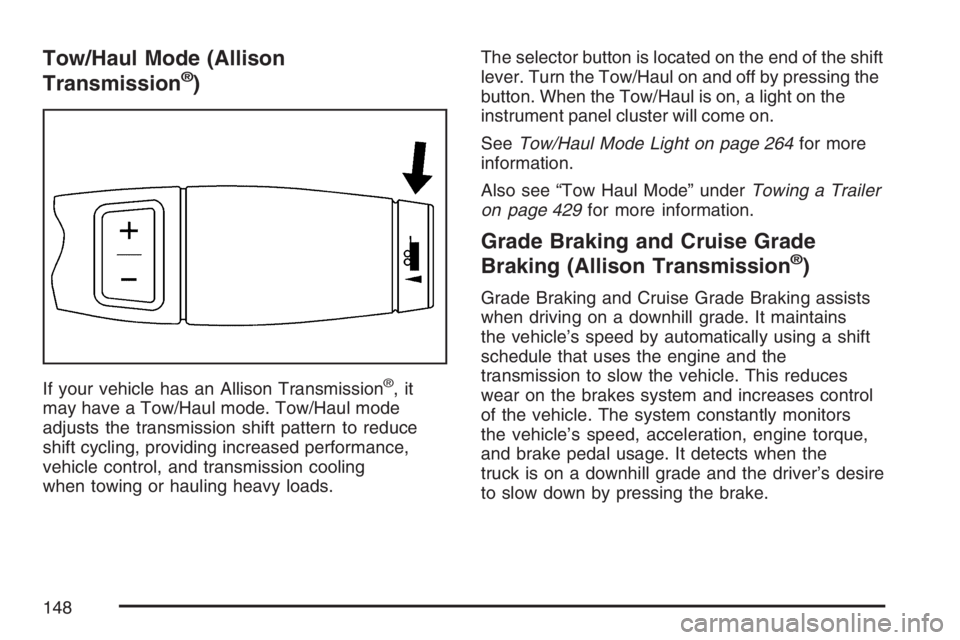
Tow/Haul Mode (Allison
Transmission®)
If your vehicle has an Allison Transmission®,it
may have a Tow/Haul mode. Tow/Haul mode
adjusts the transmission shift pattern to reduce
shift cycling, providing increased performance,
vehicle control, and transmission cooling
when towing or hauling heavy loads.The selector button is located on the end of the shift
lever. Turn the Tow/Haul on and off by pressing the
button. When the Tow/Haul is on, a light on the
instrument panel cluster will come on.
SeeTow/Haul Mode Light on page 264for more
information.
Also see “Tow Haul Mode” underTowing a Trailer
on page 429for more information.
Grade Braking and Cruise Grade
Braking (Allison Transmission®)
Grade Braking and Cruise Grade Braking assists
when driving on a downhill grade. It maintains
the vehicle’s speed by automatically using a shift
schedule that uses the engine and the
transmission to slow the vehicle. This reduces
wear on the brakes system and increases control
of the vehicle. The system constantly monitors
the vehicle’s speed, acceleration, engine torque,
and brake pedal usage. It detects when the
truck is on a downhill grade and the driver’s desire
to slow down by pressing the brake.
148
Page 149 of 674
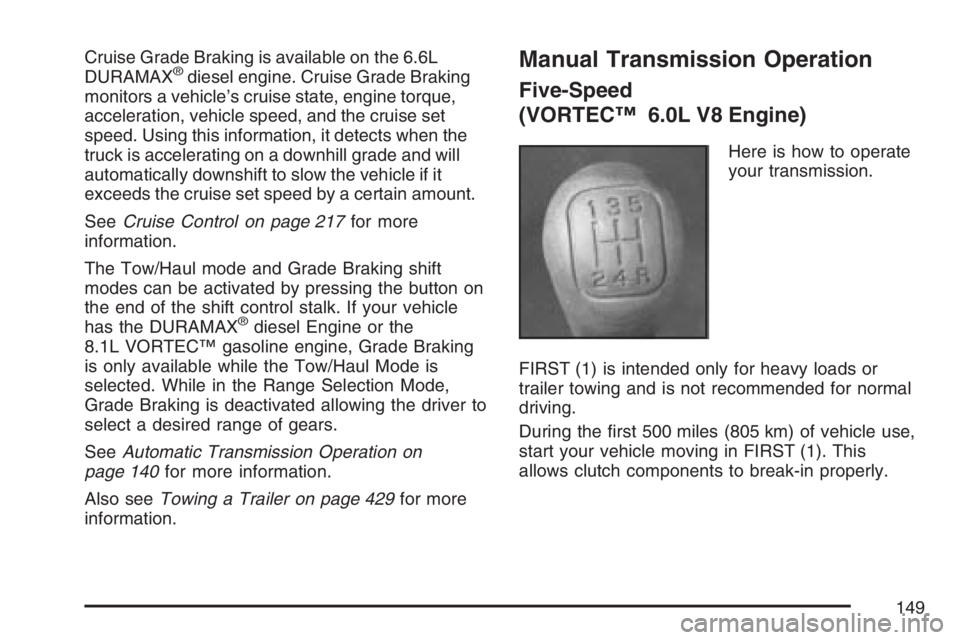
Cruise Grade Braking is available on the 6.6L
DURAMAX®diesel engine. Cruise Grade Braking
monitors a vehicle’s cruise state, engine torque,
acceleration, vehicle speed, and the cruise set
speed. Using this information, it detects when the
truck is accelerating on a downhill grade and will
automatically downshift to slow the vehicle if it
exceeds the cruise set speed by a certain amount.
SeeCruise Control on page 217for more
information.
The Tow/Haul mode and Grade Braking shift
modes can be activated by pressing the button on
the end of the shift control stalk. If your vehicle
has the DURAMAX
®diesel Engine or the
8.1L VORTEC™ gasoline engine, Grade Braking
is only available while the Tow/Haul Mode is
selected. While in the Range Selection Mode,
Grade Braking is deactivated allowing the driver to
select a desired range of gears.
SeeAutomatic Transmission Operation on
page 140for more information.
Also seeTowing a Trailer on page 429for more
information.
Manual Transmission Operation
Five-Speed
(VORTEC™ 6.0L V8 Engine)
Here is how to operate
your transmission.
FIRST (1) is intended only for heavy loads or
trailer towing and is not recommended for normal
driving.
During the �rst 500 miles (805 km) of vehicle use,
start your vehicle moving in FIRST (1). This
allows clutch components to break-in properly.
149
Page 154 of 674
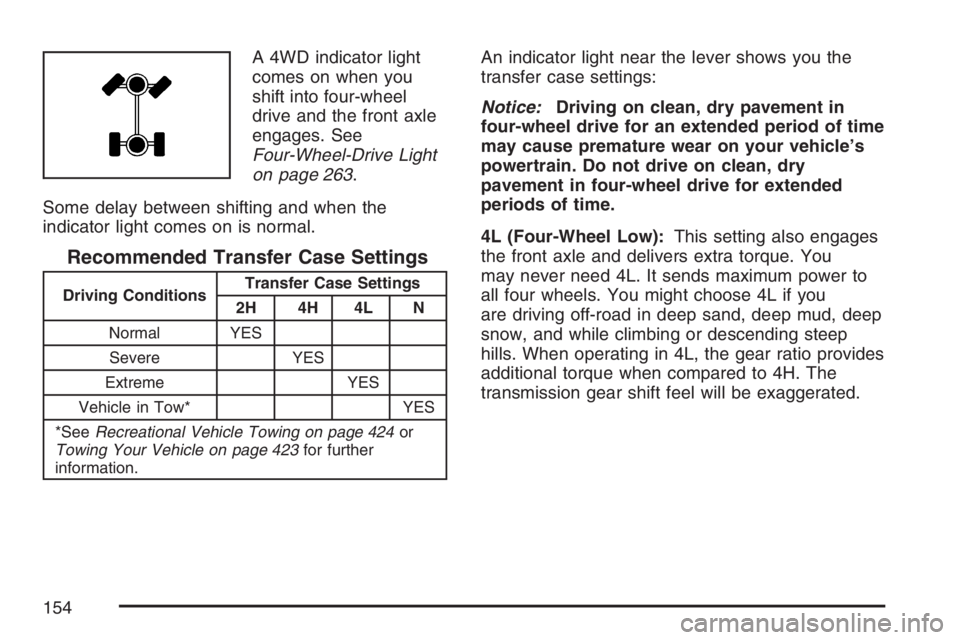
A 4WD indicator light
comes on when you
shift into four-wheel
drive and the front axle
engages. See
Four-Wheel-Drive Light
on page 263.
Some delay between shifting and when the
indicator light comes on is normal.
Recommended Transfer Case Settings
Driving ConditionsTransfer Case Settings
2H 4H 4L N
Normal YES
Severe YES
Extreme YES
Vehicle in Tow* YES
*SeeRecreational Vehicle Towing on page 424or
Towing Your Vehicle on page 423for further
information.
An indicator light near the lever shows you the
transfer case settings:
Notice:Driving on clean, dry pavement in
four-wheel drive for an extended period of time
may cause premature wear on your vehicle’s
powertrain. Do not drive on clean, dry
pavement in four-wheel drive for extended
periods of time.
4L (Four-Wheel Low):This setting also engages
the front axle and delivers extra torque. You
may never need 4L. It sends maximum power to
all four wheels. You might choose 4L if you
are driving off-road in deep sand, deep mud, deep
snow, and while climbing or descending steep
hills. When operating in 4L, the gear ratio provides
additional torque when compared to 4H. The
transmission gear shift feel will be exaggerated.
154
Page 159 of 674
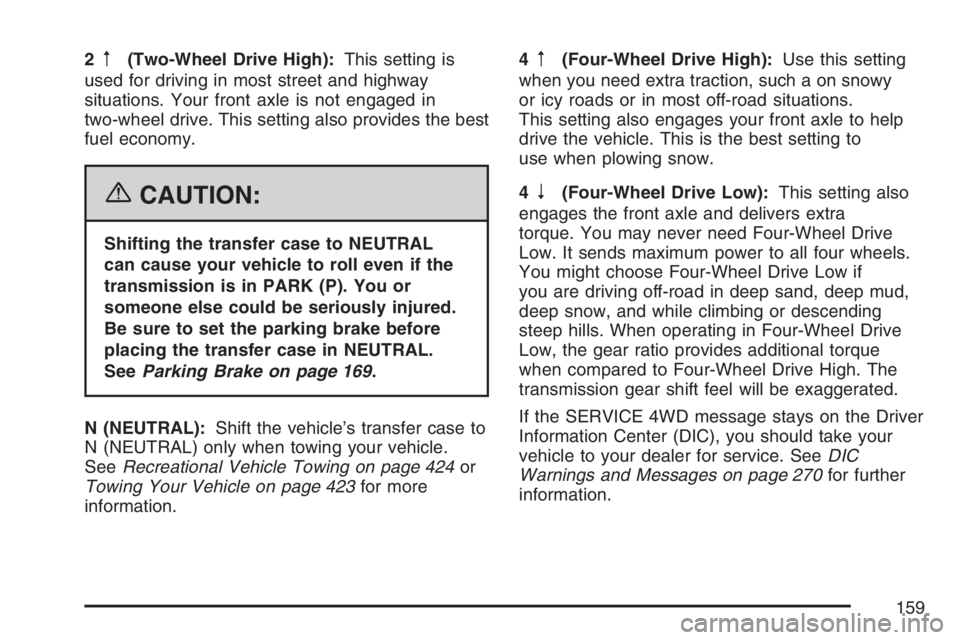
2m(Two-Wheel Drive High):This setting is
used for driving in most street and highway
situations. Your front axle is not engaged in
two-wheel drive. This setting also provides the best
fuel economy.
{CAUTION:
Shifting the transfer case to NEUTRAL
can cause your vehicle to roll even if the
transmission is in PARK (P). You or
someone else could be seriously injured.
Be sure to set the parking brake before
placing the transfer case in NEUTRAL.
SeeParking Brake on page 169.
N (NEUTRAL):Shift the vehicle’s transfer case to
N (NEUTRAL) only when towing your vehicle.
SeeRecreational Vehicle Towing on page 424or
Towing Your Vehicle on page 423for more
information.4
m(Four-Wheel Drive High):Use this setting
when you need extra traction, such a on snowy
or icy roads or in most off-road situations.
This setting also engages your front axle to help
drive the vehicle. This is the best setting to
use when plowing snow.
4
n(Four-Wheel Drive Low):This setting also
engages the front axle and delivers extra
torque. You may never need Four-Wheel Drive
Low. It sends maximum power to all four wheels.
You might choose Four-Wheel Drive Low if
you are driving off-road in deep sand, deep mud,
deep snow, and while climbing or descending
steep hills. When operating in Four-Wheel Drive
Low, the gear ratio provides additional torque
when compared to Four-Wheel Drive High. The
transmission gear shift feel will be exaggerated.
If the SERVICE 4WD message stays on the Driver
Information Center (DIC), you should take your
vehicle to your dealer for service. SeeDIC
Warnings and Messages on page 270for further
information.
159
Page 165 of 674
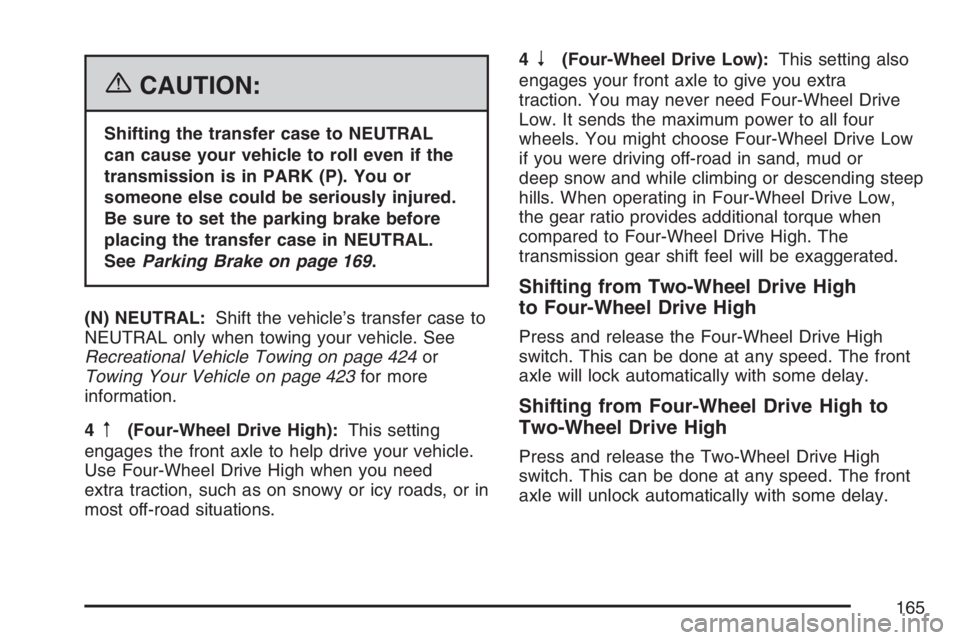
{CAUTION:
Shifting the transfer case to NEUTRAL
can cause your vehicle to roll even if the
transmission is in PARK (P). You or
someone else could be seriously injured.
Be sure to set the parking brake before
placing the transfer case in NEUTRAL.
SeeParking Brake on page 169.
(N) NEUTRAL:Shift the vehicle’s transfer case to
NEUTRAL only when towing your vehicle. See
Recreational Vehicle Towing on page 424or
Towing Your Vehicle on page 423for more
information.
4
m(Four-Wheel Drive High):This setting
engages the front axle to help drive your vehicle.
Use Four-Wheel Drive High when you need
extra traction, such as on snowy or icy roads, or in
most off-road situations.4
n(Four-Wheel Drive Low):This setting also
engages your front axle to give you extra
traction. You may never need Four-Wheel Drive
Low. It sends the maximum power to all four
wheels. You might choose Four-Wheel Drive Low
if you were driving off-road in sand, mud or
deep snow and while climbing or descending steep
hills. When operating in Four-Wheel Drive Low,
the gear ratio provides additional torque when
compared to Four-Wheel Drive High. The
transmission gear shift feel will be exaggerated.
Shifting from Two-Wheel Drive High
to Four-Wheel Drive High
Press and release the Four-Wheel Drive High
switch. This can be done at any speed. The front
axle will lock automatically with some delay.
Shifting from Four-Wheel Drive High to
Two-Wheel Drive High
Press and release the Two-Wheel Drive High
switch. This can be done at any speed. The front
axle will unlock automatically with some delay.
165
Page 171 of 674
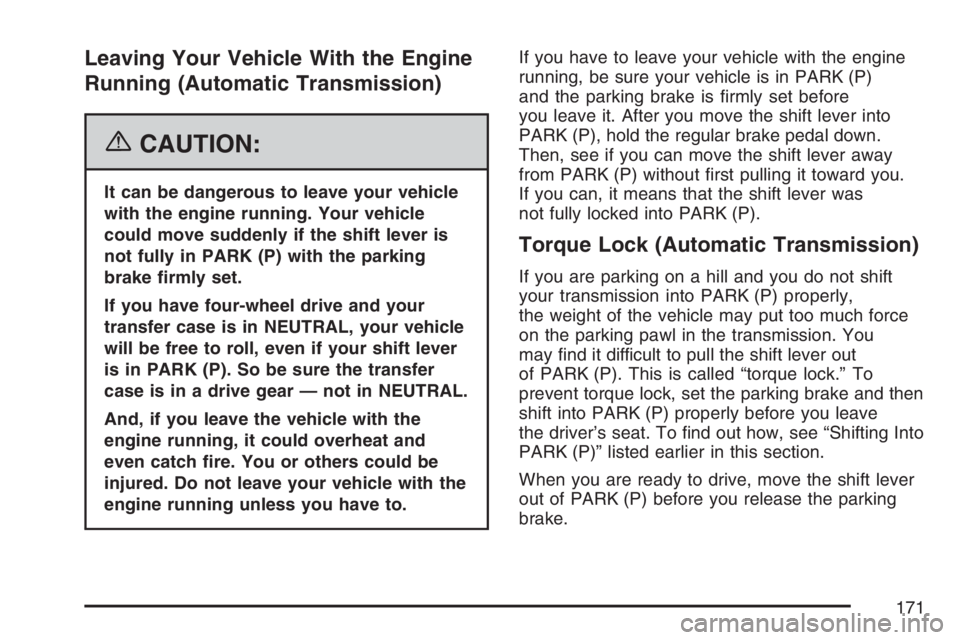
Leaving Your Vehicle With the Engine
Running (Automatic Transmission)
{CAUTION:
It can be dangerous to leave your vehicle
with the engine running. Your vehicle
could move suddenly if the shift lever is
not fully in PARK (P) with the parking
brake �rmly set.
If you have four-wheel drive and your
transfer case is in NEUTRAL, your vehicle
will be free to roll, even if your shift lever
is in PARK (P). So be sure the transfer
case is in a drive gear — not in NEUTRAL.
And, if you leave the vehicle with the
engine running, it could overheat and
even catch �re. You or others could be
injured. Do not leave your vehicle with the
engine running unless you have to.If you have to leave your vehicle with the engine
running, be sure your vehicle is in PARK (P)
and the parking brake is �rmly set before
you leave it. After you move the shift lever into
PARK (P), hold the regular brake pedal down.
Then, see if you can move the shift lever away
from PARK (P) without �rst pulling it toward you.
If you can, it means that the shift lever was
not fully locked into PARK (P).
Torque Lock (Automatic Transmission)
If you are parking on a hill and you do not shift
your transmission into PARK (P) properly,
the weight of the vehicle may put too much force
on the parking pawl in the transmission. You
may �nd it difficult to pull the shift lever out
of PARK (P). This is called “torque lock.” To
prevent torque lock, set the parking brake and then
shift into PARK (P) properly before you leave
the driver’s seat. To �nd out how, see “Shifting Into
PARK (P)” listed earlier in this section.
When you are ready to drive, move the shift lever
out of PARK (P) before you release the parking
brake.
171